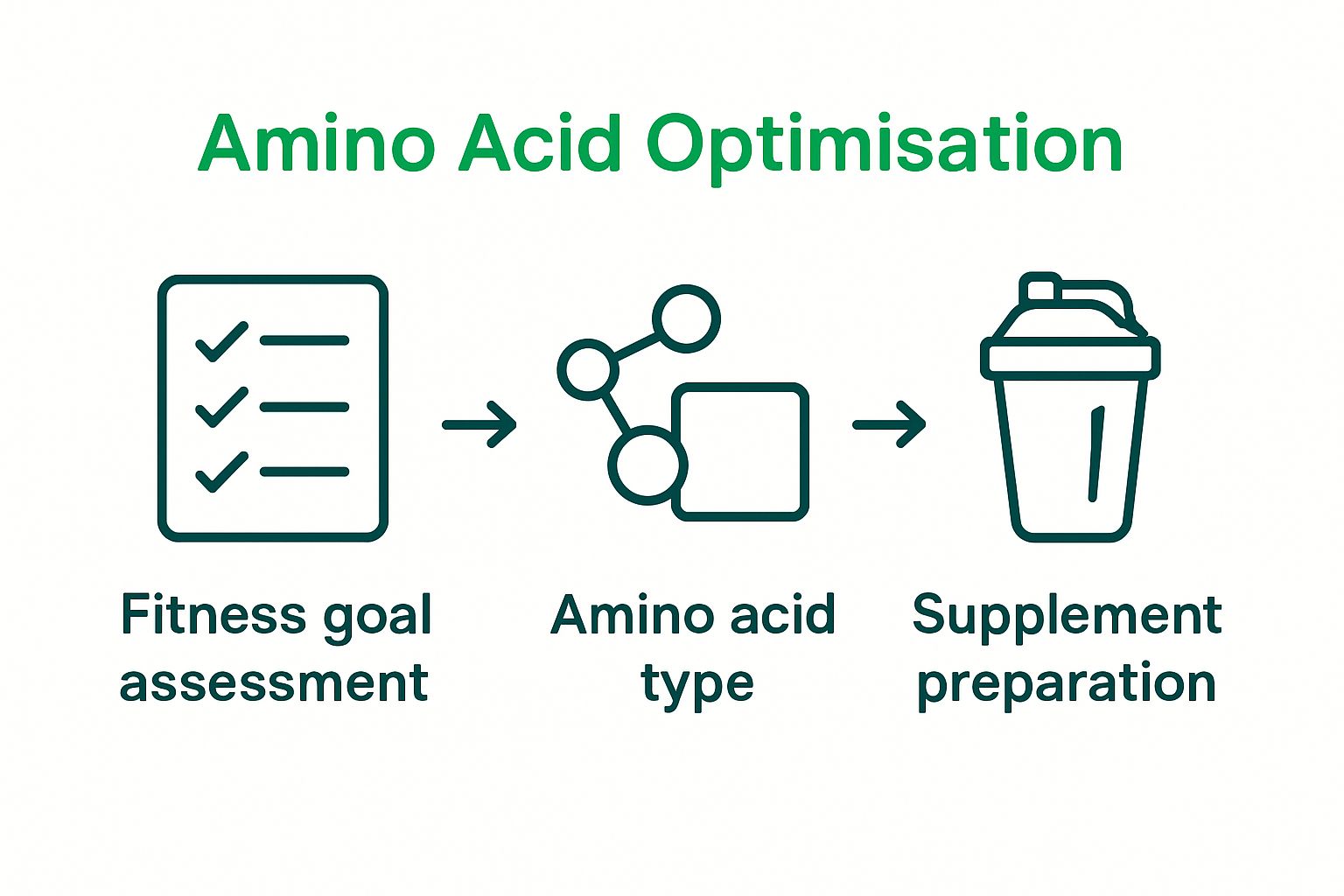Amino acids are often billed as the secret behind stronger muscles and quicker recovery, yet most people treat them as a one-size-fits-all fix. Surprising as it sounds, there are nine essential amino acids the body simply cannot make on its own, and not all of them work the same for every goal. Picking random supplements can do more harm than good, and the real key lies in customising your approach to suit your own training targets and body chemistry. The strategy is far more nuanced than most realise.
Table of Contents
- Step 1: Assess Your Fitness Goals
- Step 2: Choose the Right Amino Acids
- Step 3: Determine the Optimal Dosage
- Step 4: Incorporate Amino Acids into Your Diet
- Step 5: Monitor Your Progress and Adjust Intake
Quick Summary
| Key Point | Explanation |
|---|---|
| 1. Assess fitness goals first | Clearly define your specific fitness objectives to tailor amino acid supplementation effectively. |
| 2. Choose suitable amino acids | Select amino acids that align with your fitness aims, as their functions vary significantly. |
| 3. Determine proper dosage | Personalise your amino acid intake based on body weight and training intensity to achieve optimal results. |
| 4. Incorporate into daily diet | Use whole foods to complement amino acids, ensuring proper intake around your training schedule. |
| 5. Monitor and adjust consistently | Regularly track your progress and adjust your supplementation based on performance metrics and responses. |
Step 1: Assess Your Fitness Goals
Understanding your precise fitness objectives forms the critical foundation for strategically integrating amino acids into your performance nutrition plan. Your individual goals will directly influence which amino acid protocols will most effectively support your physiological requirements. Whether you aim to build muscle mass, enhance endurance, accelerate recovery, or improve overall athletic performance, tailoring your amino acid supplementation becomes a nuanced and personalised approach.
Understanding Performance Objectives
Muscle builders require different amino acid strategies compared to endurance athletes. Powerlifters seeking hypertrophy will prioritise branched-chain amino acids (BCAAs) that stimulate muscle protein synthesis, while marathon runners might focus on amino acids that support sustained energy and reduce muscular breakdown.
Below is a summary table comparing the fitness goals discussed in the article with the recommended amino acid focus and strategic considerations for each.
| Fitness Goal | Amino Acid Focus | Strategic Considerations |
|---|---|---|
| Muscle Building | Branched-chain amino acids (BCAAs) | Prioritise muscle protein synthesis and hypertrophy |
| Endurance Enhancement | Amino acids for sustained energy (e.g. glutamine) | Support energy production and reduce muscle breakdown |
| Recovery Acceleration | Essential amino acids with emphasis on leucine/glutamine | Enhance repair, reduce soreness, and shorten downtime |
| Overall Athletic Performance | Comprehensive essential amino acids | Balance energy, synthesis, and overall adaptation |
Your assessment should involve a comprehensive evaluation of your current fitness level, training intensity, and specific performance metrics. Consider tracking parameters such as current strength levels, body composition, recovery times, and energy expenditure. These data points will help you create a targeted approach to amino acid supplementation. Check out our guide on performance enhancement supplements to gain deeper insights into optimising your nutritional strategy.
To effectively assess your fitness goals, create a structured plan that includes:

- Specific, measurable performance targets
- Current baseline measurements
- Anticipated physiological adaptations
- Expected timelines for performance improvements
Remember that amino acid supplementation is not a one-size-fits-all solution. Your unique metabolic profile, training regimen, and physiological response will determine the most effective approach. Consulting with a sports nutritionist or experienced fitness professional can provide personalised insights tailored to your specific performance objectives.
Step 2: Choose the Right Amino Acids
Selecting the appropriate amino acids represents a strategic decision that can significantly impact your fitness performance and physiological adaptation. Not all amino acids function identically, and understanding their unique roles will empower you to craft a targeted supplementation approach that aligns precisely with your fitness objectives.
Essential Amino Acid Considerations
The human body requires a comprehensive spectrum of amino acids, but nine are considered essential amino acids that cannot be produced internally. These include histidine, isoleucine, leucine, lysine, methionine, phenylalanine, threonine, tryptophan, and valine. Branched-chain amino acids (BCAAs) — leucine, isoleucine, and valine — play a particularly crucial role in muscle protein synthesis and recovery. Learn more about EAA supplements and their comprehensive benefits to understand their intricate physiological mechanisms.
Different amino acid combinations target specific fitness outcomes. Endurance athletes might prioritise glutamine for recovery, while strength trainers could focus on leucine to stimulate muscle growth. Your selection should mirror your precise performance goals, metabolic requirements, and training intensity. Understanding the nuanced interactions between various amino acids allows for a sophisticated, personalised supplementation strategy.
Consider these critical factors when selecting amino acids:
- Individual metabolic profile and genetic predispositions
- Current training volume and intensity
- Specific performance objectives
- Potential interactions with existing nutritional intake
Professional athletes and fitness enthusiasts recognise that amino acid supplementation is not a generic solution but a precision nutritional intervention. Consulting with sports nutritionists can provide tailored guidance, ensuring your amino acid protocol is scientifically calibrated to your unique physiological landscape. The goal is not just consumption, but strategic optimisation of your body’s biochemical potential.
Step 3: Determine the Optimal Dosage
Determining the precise amino acid dosage represents a critical junction in your supplementation strategy where scientific understanding meets individual physiological requirements. Your dosage must be meticulously calibrated to balance maximal performance enhancement with metabolic efficiency, avoiding both under and over-supplementation.
Personalised Dosage Calculation
Body weight, training intensity, and specific fitness objectives serve as fundamental parameters for establishing your amino acid intake. Generally, most athletes require between 5 to 10 grams of essential amino acids per serving, with variations depending on muscle-building, endurance, or recovery goals. Explore our comprehensive guide on protein synthesis to understand the intricate mechanisms underlying amino acid utilisation.
Starting with a conservative baseline dosage allows your body to adapt and minimise potential digestive disruptions. Beginners might commence with 3-5 grams per serving, gradually incrementing based on physiological response and training demands. Professional athletes often consume higher quantities, ranging from 10-15 grams, but this should never be a universal prescription. Individual metabolic variance means what works optimally for one person might prove suboptimal for another.
This table outlines typical amino acid dosage ranges, considerations for personalisation, and recommended timing, helping you customise intake based on your training and physiological needs.
| User Type | Dosage Range per Serving | Timing Guidance | Adjustment Considerations |
|---|---|---|---|
| Beginner | 3-5g | Pre- or post-workout | Start conservatively, monitor response |
| Regular Athlete | 5-10g | Immediately before/after training | Reflect changes in training volume |
| Professional Athlete | 10-15g | Split dose pre- and post-exercise | Based on performance & recovery needs |
| Individualised Plan | Varies | Aligned to personal schedule | Adjust per metabolic and training needs |
Consider these strategic dosage considerations:
- Track your body’s initial response to amino acid supplementation
- Monitor performance metrics and recovery rates
- Adjust intake proportionally with changes in training volume
- Consult healthcare professionals for personalised guidance
Timing represents another crucial aspect of amino acid dosage management. Consuming your supplement immediately before or after training maximises absorption and muscle protein synthesis. Some athletes prefer split dosages — consuming a portion pre-workout and the remainder post-exercise — to maintain a consistent amino acid environment within their muscular system. Remember, supplementation is a nuanced art of understanding your body’s unique biochemical language and responding accordingly.

Step 4: Incorporate Amino Acids into Your Diet
Transforming amino acid supplementation from a theoretical concept into a practical nutritional strategy requires thoughtful integration into your daily dietary routine. This step transcends simple supplementation, focusing on creating a comprehensive nutritional ecosystem that supports your fitness performance and metabolic efficiency.
Strategic Dietary Integration
Whole food sources remain the foundation of amino acid intake, with supplements serving as a targeted enhancement rather than a complete replacement. Lean proteins such as chicken, fish, eggs, and legumes provide a natural spectrum of amino acids that work synergistically with your supplementation protocol. Explore our comprehensive guide on high protein diets to understand the broader nutritional context of protein consumption.
Timing becomes crucial in amino acid dietary integration. Consuming protein and amino acid supplements around your training window maximises muscle protein synthesis and recovery potential. Pre-workout consumption can provide readily available amino acids for energy production, while post-exercise intake supports muscle repair and growth. Many athletes split their amino acid intake, consuming a portion before training and the remainder immediately after, creating a continuous nutritional environment conducive to performance enhancement.
Consider these strategic dietary incorporation principles:
- Balance whole food protein sources with targeted amino acid supplementation
- Synchronise supplement intake with your specific training schedule
- Monitor your body’s response and energy levels
- Maintain consistent nutritional patterns
Successful amino acid integration requires more than mechanical consumption. It demands a holistic understanding of your body’s unique metabolic requirements. Paying attention to how different food combinations and supplement timing impact your energy, recovery, and performance will help you refine your approach. The goal is not just consuming amino acids, but orchestrating a nuanced nutritional strategy that elevates your physiological potential and supports sustained fitness progression.
Step 5: Monitor Your Progress and Adjust Intake
Progressively tracking and refining your amino acid supplementation strategy represents the pinnacle of intelligent nutritional management. This final step transforms your approach from static consumption to a dynamic, responsive nutritional intervention that evolves alongside your physiological development and fitness objectives.
Performance Tracking Methodology
Systematic observation becomes your primary diagnostic tool for assessing amino acid supplementation effectiveness. Implementing a comprehensive tracking system involves monitoring multiple performance indicators, including strength metrics, recovery rates, muscle definition, energy levels, and overall physiological response. Discover insights into exercise health benefits to understand the holistic approach to fitness tracking.
Quantitative measurements provide objective evidence of your supplementation’s impact. Maintain a detailed training journal documenting key performance parameters such as workout intensity, repetition volumes, recovery times, and subjective energy experiences. Photograph your physical progression, measure body composition, and conduct regular strength assessments to generate tangible data points. These metrics will reveal whether your current amino acid protocol is delivering the desired physiological adaptations.
Consider these critical progress monitoring strategies:
- Establish baseline measurements before initiating amino acid supplementation
- Record consistent, objective performance indicators
- Assess both physiological and psychological responses
- Be prepared to modify your approach based on empirical evidence
Successful progress monitoring requires patience, scientific curiosity, and a willingness to experiment. Your body’s response to amino acid supplementation is uniquely personal, influenced by genetics, training style, nutrition, and recovery practices. Treat your supplementation strategy as a continuously evolving protocol, making incremental adjustments based on accumulated evidence. The ultimate goal transcends mere supplementation — it is about creating a sophisticated, responsive nutritional ecosystem that propels your fitness performance to unprecedented heights.
Make Every Workout Count With Tailored Amino Acid Supplementation
You have just learnt how targeted amino acid strategies can make a real difference to your training outcomes, from building muscle to speeding up recovery and fuelling endurance. Yet the path to optimal results is rarely straightforward. Common struggles such as finding the right blend of essential amino acids, accurately dosing for your needs, and monitoring your progress can make the journey confusing and overwhelming.

Why settle for uncertainty when your fitness deserves precision? At MyGymSupplements.shop, you can find expertly curated amino acid formulas, protein blends, and performance support products that match your personalised training goals. Join a community focused on performance and well-being and take out the guesswork with options designed for muscle gains, advanced recovery, and energy enhancement. Start making your plan a reality today by exploring the full range and let your next workout be your strongest yet. For tailored recommendations and easy shopping, visit MyGymSupplements.shop and experience the difference first-hand.
Frequently Asked Questions
What are amino acids and how do they support fitness performance?
Amino acids are organic compounds that serve as the building blocks of proteins. They play various roles in enhancing fitness performance, including muscle protein synthesis, energy production, and recovery support. Different amino acids are suited for specific fitness goals, such as muscle building or endurance.
How do I choose the right amino acids for my fitness goals?
Selecting the appropriate amino acids involves assessing your specific performance objectives. For muscle growth, focus on branched-chain amino acids (BCAAs), while endurance athletes may benefit from glutamine or other amino acids that help reduce muscle breakdown and support sustained energy.
What is the optimal dosage of amino acids for athletes?
Most athletes typically require between 5 to 10 grams of essential amino acids per serving, varying based on individual metabolic needs and fitness goals. Beginners may start with lower doses, gradually increasing as they gauge their body’s response to supplementation.
How can I effectively incorporate amino acids into my diet?
Integrating amino acids into your diet involves balancing whole food sources of protein, like chicken, fish, and legumes, with targeted supplementation. Timing your amino acid intake around your workouts, both pre and post-exercise, can maximise muscle protein synthesis and recovery efficiency.
Recommended
- What is EAA Supplement? Understanding Its Importance – MyGymSupplements
- What is High Protein Diet? Understanding Its Benefits – MyGymSupplements
- What is Muscle Protein Synthesis? Understanding Its Importance – MyGymSupplements
- What is Protein Synthesis? Understanding Its Importance – MyGymSupplements



0 comments